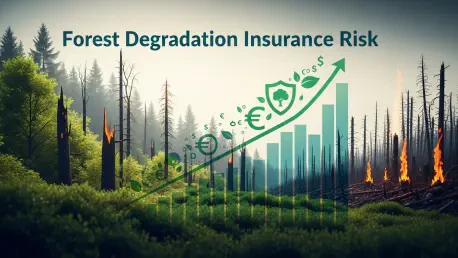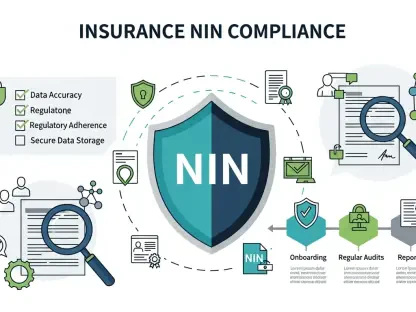What happens when the silent guardians of the planet, vast forests stretching across continents, crumble under the weight of human progress, dragging billions in financial stability down with them? The insurance industry stands on the edge of a staggering $279 billion risk, a figure unveiled by a recent report from CDP, as forest degradation accelerates at an alarming pace. This isn’t merely an environmental crisis—it’s a financial reckoning that could reshape how insurers and corporations operate in a world increasingly scarred by deforestation. The numbers are stark, the stakes are high, and the time to act is slipping away.
The Hidden Cost of Vanishing Forests: A Financial Alarm
The sheer scale of forest loss is a wake-up call that echoes far beyond tree lines. Forests, often dubbed the lungs of Earth, absorb massive amounts of carbon dioxide, stabilizing the climate while holding an economic value estimated at $150 trillion by Boston Consulting Group. Yet, with deforestation poised to erode 30% of this value by 2050, the financial ripple effects are undeniable, hitting insurers hardest as they grapple with unpriced climate risks tied to this loss.
This crisis isn’t abstract—it’s measurable and immediate. In just one year, 6.7 million hectares of primary rainforest vanished, an 80% surge compared to the prior period, releasing 3.1 gigatons of greenhouse gases into the atmosphere. For insurers, this translates into heightened exposure across sectors like agriculture and infrastructure, where forest degradation fuels volatility and claims.
The importance of this issue cannot be overstated. Insurers, tasked with safeguarding against uncertainty, now face a blind spot that could cost billions, while corporations tied to deforestation exacerbate the problem. This story isn’t just about trees—it’s about the stability of global markets and the urgent need to recalibrate risk in a rapidly changing world.
Why Forest Degradation Hits Insurers Hard
Beyond their environmental role, forests underpin economic systems that insurers rely on. Their ability to sequester 14.4 gigatons of CO₂ equivalent each year mitigates climate shifts that, if unchecked, trigger extreme weather events and agricultural losses—events insurers must cover. As deforestation dismantles this natural buffer, the frequency and severity of such claims are climbing, straining balance sheets.
The connections are intricate but direct. Supply chains in industries like agriculture, responsible for 33% of forest loss since 2001, are deeply intertwined with insured assets. When forests disappear, so does the stability of these sectors, leaving insurers exposed to cascading failures that few have fully accounted for in their risk models.
Moreover, the systemic nature of this threat extends to financial institutions managing $30 trillion in assets, many of which remain unaware of their indirect links to deforestation through commodity chains. This lack of visibility creates a dangerous gap, amplifying vulnerabilities across the insurance landscape and beyond.
Breaking Down the $279 Billion Threat
The $279 billion risk figure isn’t a random estimate—it’s a meticulously calculated warning. CDP’s analysis highlights how deforestation-driven climate impacts, including intensified storms and crop failures, are inflating costs that insurers must absorb. This exposure averages $338 million per company, a burden that many are unprepared to shoulder due to inadequate data.
Key drivers of this risk include logging, wildfires, and agricultural expansion, each tying corporate activities to environmental destruction. These activities not only degrade ecosystems but also destabilize insured properties and operations, creating a feedback loop of financial strain that’s hard to escape.
Perhaps most concerning is the data shortfall. Of over 827 companies reporting forest-related risks, fewer than half have quantified the financial fallout, leaving insurers in the dark about the true extent of their liabilities. This uncertainty is a ticking time bomb, threatening to unravel portfolios if left unaddressed.
Voices from the Edge: Insights and Corporate Action
CDP’s report, with its sharp focus on unpriced climate exposures, sounds a clear alarm for insurers. Titled with an emphasis on hidden financial implications, it argues that without immediate intervention, the industry risks being blindsided by losses tied to forest loss. This perspective underscores a critical need for systemic change in how risks are assessed and managed.
Corporate leaders, however, are beginning to respond. Jim Andrew, PepsiCo’s Chief Sustainability Officer, points to initiatives like the Forest Positive Coalition, aiming for deforestation-free sourcing by the end of this year. “Collaboration across industries is the only way to tackle this at scale,” Andrew notes, highlighting a push for collective impact.
Other companies echo this urgency with innovative approaches. Tesco’s UK CEO Ashwin Prasad discusses their adoption of LEAF Marque certification to ensure sustainable farming practices among suppliers, while Bunge’s Rossano de Angelis Jr. champions blockchain for tracing soy supply chains free of deforestation. These efforts, though promising, are fragments of a larger puzzle that CDP warns must be solved cohesively to avert disaster.
Charting a Path Through the Crisis: Solutions for Insurers
Facing a $279 billion shadow, insurers and corporations must pivot to actionable strategies. A starting point is comprehensive risk assessments, as CDP advocates, to map dependencies on forests and quantify potential impacts. Such clarity would enable more accurate underwriting and protect portfolios from unforeseen shocks.
Transparency tools offer another lifeline. Blockchain and similar technologies can trace supply chains, rooting out links to deforestation and allowing companies to pivot toward sustainable practices. Insurers, in turn, can use this data to refine policies and premiums, aligning financial incentives with environmental goals.
Collaboration is equally critical. Industry coalitions, like those supported by the Consumer Goods Forum, can amplify individual efforts, while insurers develop specialized climate models factoring in deforestation trends. These steps, taken together, provide a blueprint to mitigate losses and preserve the vital ecosystems that anchor global stability.
Reflecting on a Turning Point
Looking back, the warnings about forest degradation and its $279 billion risk to insurers stood as a pivotal moment for the industry. The staggering data and corporate responses of that time revealed a dual challenge—environmental loss and financial exposure—that demanded urgent action. It became clear that ignoring these blind spots was no longer an option.
The path forward crystallized around collaboration and innovation. Insurers began refining risk models with deforestation data, while corporations scaled sustainable practices through shared initiatives. These efforts marked early steps, but the real test lay in sustaining momentum to prevent further erosion of both forests and financial security.
Ultimately, the crisis highlighted a profound truth: protecting the planet’s lungs was not just an ecological imperative but a financial one. The industry had to continue integrating climate realities into every decision, ensuring that future strategies balanced profit with preservation for a more resilient tomorrow.









